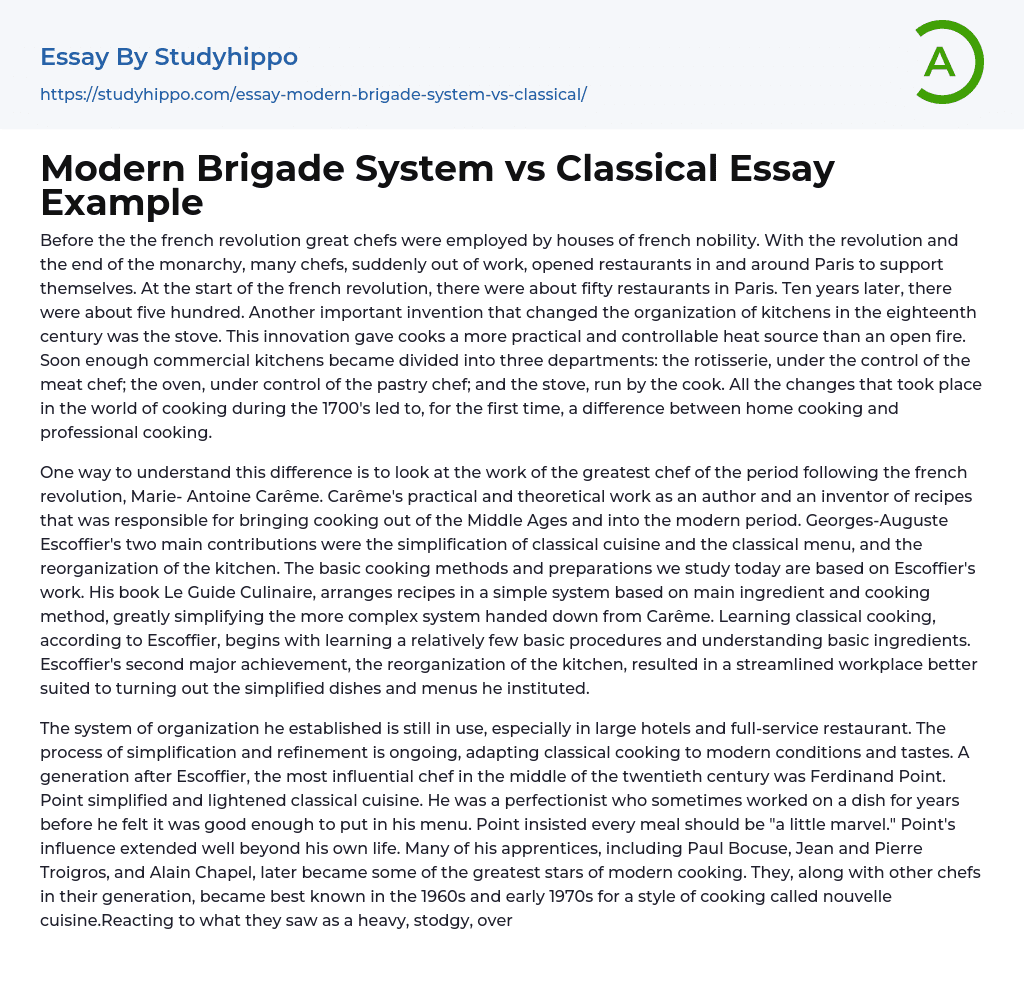Before the the french revolution great chefs were employed by houses of french nobility. With the revolution and the end of the monarchy, many chefs, suddenly out of work, opened restaurants in and around Paris to support themselves. At the start of the french revolution, there were about fifty restaurants in Paris. Ten years later, there were about five hundred. Another important invention that changed the organization of kitchens in the eighteenth century was the stove. This innovation gave cooks a more practical and controllable heat source than an open fire. Soon enough commercial kitchens became divided into three departments: the rotisserie, under the control of the meat chef; the oven, under control of the pastry chef; and the stove, run by the cook. All the changes that took place in the world of cooking during the 1700's led to, for
...the first time, a difference between home cooking and professional cooking.
One way to understand this difference is to look at the work of the greatest chef of the period following the french revolution, Marie- Antoine Carême. Carême's practical and theoretical work as an author and an inventor of recipes that was responsible for bringing cooking out of the Middle Ages and into the modern period. Georges-Auguste Escoffier's two main contributions were the simplification of classical cuisine and the classical menu, and the reorganization of the kitchen. The basic cooking methods and preparations we study today are based on Escoffier's work. His book Le Guide Culinaire, arranges recipes in a simple system based on main ingredient and cooking method, greatly simplifying the more complex system handed down from Carême. Learning classical
cooking, according to Escoffier, begins with learning a relatively few basic procedures and understanding basic ingredients. Escoffier's second major achievement, the reorganization of the kitchen, resulted in a streamlined workplace better suited to turning out the simplified dishes and menus he instituted.
The system of organization he established is still in use, especially in large hotels and full-service restaurant. The process of simplification and refinement is ongoing, adapting classical cooking to modern conditions and tastes. A generation after Escoffier, the most influential chef in the middle of the twentieth century was Ferdinand Point. Point simplified and lightened classical cuisine. He was a perfectionist who sometimes worked on a dish for years before he felt it was good enough to put in his menu. Point insisted every meal should be "a little marvel." Point's influence extended well beyond his own life. Many of his apprentices, including Paul Bocuse, Jean and Pierre Troigros, and Alain Chapel, later became some of the greatest stars of modern cooking. They, along with other chefs in their generation, became best known in the 1960s and early 1970s for a style of cooking called nouvelle cuisine.Reacting to what they saw as a heavy, stodgy, overly complicated classical cuisine, these chefs took Point's lighter approach even further. They rejected many traditional principles, such as the use of flour to thicken sauces, and instead urged simpler, more natural flavors and preparations, with lighter sauces and seasonings and shorter cooking times. In traditional classical cuisine, many dishes were plated in the dining room by waiters. Nouvelle cuisine, however, placed a great deal of emphasis on artful plating presentation done by the chef in the
kitchen. Very quickly this "simpler" style became extravagant and complicated, famous for strange combinations of foods and fussy, ornate arrangements and designs.
The purpose of kitchen organization is to assign or allocate tasks so they can be done efficiently and properly and so all workers know what their responsibilities are. The menu is the basis of the entire operation. The classical brigade system. The chef is the person in charge of the kitchen. The sous chef is directly in charge of production and works as the assistant to the executive chef or chef de cuisine. Station chefs are in charge of particular areas of production. The expediter accepts orders from waiters and passes them on to the cooks on the line. The expediter also calls for orders to be finished and plated at the proper time and inspects each plate before passing it to the dining room staff. Only a large establishment need a staff like the classical brigade.
- Business Law essays
- Contract essays
- Consumer Protection essays
- Property essays
- Ownership essays
- Agreement essays
- Common Law essays
- Contract Law essays
- Justice essays
- Security essays
- Tort Law essays
- United States Constitution essays
- Crime essays
- Lawsuit essays
- Treaty essays
- Family Law essays
- Marijuana Legalization essays
- Constitution essays
- War on Drugs essays
- Court essays
- Jury essays
- Police essays
- Protection essays
- Community Policing essays
- Criminal Law essays
- Judge essays
- Lawyer essays
- Employment Law essays
- Copyright Infringement essays
- Injustice essays
- Intellectual Property essays
- Breach Of Contract essays
- Jurisprudence essays
- Social Injustice essays
- Juvenile Justice essays
- Internet Privacy essays
- Cyber Security essays
- Bill Of Rights essays
- Civil Liberties essays
- First Amendment To The United States Constitution essays
- Fourth Amendment To The United States Constitution essays
- Second amendment essays
- Animal Cruelty essays
- Law Enforcement essays
- Juvenile Justice System essays
- Surveillance essays
- Forensic Science essays
- Crime Prevention essays
- Criminal Justice essays
- Criminology essays




